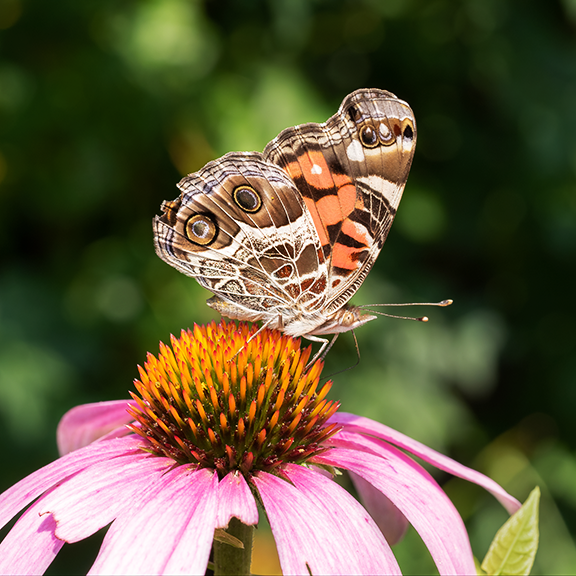Disclaimer: data only available for the lower 48 United States, although Southern Canada and Northern Mexico should be able to extrapolate
The Xerces Society is an insect conservation nonprofit organization based in Portland, Oregon. They engage in a variety of work to protect native insects, including publishing resources for the general public.
One such resource are their Native Plants for Pollinators and Beneficial Insects guides, which are curated illustrated lists of plants broken down by geographic region. The lists include basic growing conditions info for each species, as well as some info on how the plants benefit insects. They even have separate lists specifically for supporting the endangered monarch butterfly.
If you’re a native plant fanatic like me you can cross-reference their lists with the USDA Plants Database (I wrote about that other great resource in this post here) to verify if the Xerces-recommended plants are native to your county, however the Xerces lists are broken up into relatively small regions so you’re unlikely to cause damage or introduce problematic species even if it’s not technically native to your specific county.
I hope y’all find these lists as useful/inspiring as I have!



I don’t know of any seed bomb companies per se, but there are numerous plants that I can think of off the top of my head that grow relatively easily from seed, even with minimal care. Can’t give you any specific recommendations without knowing where you live, but in my experience where I live (PNW) fireweed, lupine, yarrow, rabbit brush, milkweed, and selfheal are easy to grow from seed. Miner’s lettuce also grows easily from seed, although I don’t know if it’s beneficial to insects (the leaves are edible, however! Hence the name)
For where to source the seeds, it’s best to find a place as close as possible to where you live. Plant starts are expensive to buy online (cuz shipping) but seeds are usually pretty cheap. Some example companies I’ve bought from before that have expansive native seed catalogues: https://westernnativeseed.com (Colorado), https://klamathsiskiyouseeds.com/ (South-Central Oregon), and http://www.insidepassageseeds.com/ (NW Washington). There are some directories of native seed companies out there, but many are out of date. Best bet is to do an Internet search for [your state] + native seeds and see what pops up, or to search for [desired plant] + seed for sale and select the location closest to you. Most of these companies are passionate and knowledgeable about native plants and may be able to give you curated advice on the easiest-to-grow seeds they carry for your region.
Thank you for the resources! I’m in SE Pennsylvania. I did see some have "weed’ in the name so they sound like they should be easy to grow, just nothing I’ve ever seen in a garden center or the seed station at one of the garden sections of a mega store. I’ll have to see what I can find. I’m semi-rural so there should be some good patched to plant these things, I just dont know where to get them or how to start them. I know some stuff can be transplanted, but others cant and I dont really know how to tell.
You’re generally not going to find many native plants in big box stores (or often you’ll find non-native varieties of native plants); online shopping is really your best bet for seeds, and local garden shops (vs national chains) for starts.
For your region, Prunella vulgaris aka selfheal, is a good option for scatter-and-forget. The plants are a little shorter, so they will grow in mowed grass lawns like clover does, although if they’re not mowed they’ll get to about a foot tall (this means they may struggle to survive if planted among tall grasses/shrubs). Each plant produces many seeds each summer, so the seeds are small and plentiful. The purple flowers are small but pretty splashes of color. In my region (PNW) they are evergreen. On the taller side, Chamerion angustifolium aka fireweed, is another easy-grower. It grows 4-6 feet tall and produces stalks of lovely pink flowers that bees absolutely adore, and fun wispy seeds in the autumn. The plants die back entirely every autumn and resprout in the spring, propogated by both root and wind-blown seed. They make lovely clumps that are good along fences or a sunny corner of the yard, and can grow in more crowded meadow-like conditions. My final recommendation for a seed-scattering choice is lupine; there are many lupine varieties so make sure you get the right one for your area. It looks like Lupinus perennis aka sundial lupine is native to most of PA and is a smaller, more manageable variety (some lupine varieties can get to be 6+ feet tall and just as wide!). Bees also love lupine flowers, and lupine are less wild-looking than selfheal or fireweed, in case you have neighbors who care about that kind of thing (lupine are popular garden flowers). My final recommendation is Asclepias syriaca, aka common milkweed. This is a critical plant for monarch butterflies (it’s the only plant the caterpillars can eat), but it has questionable benefit for other insects so don’t plant it in isolation. It also is toxic, so keep it away from where children or pets play. The plants die back in autumn and resprout in the spring. All the above recommended plants produce many seeds every year (and many are perennial or will resprout from established roots) so once they’ve gotten established you should be good to go. I know you said you want to be hands-off, however giving them a little help during their first year will greatly increase success rates; this means clearing away competing vegetation and watering during dry spells (as well as being strategic where you scatter seeds, rather than blindly yeeting them wherever).
In doing this research I stumbled across https://www.keystonewildflowers.com/, which is based in SE PA; I’m sure they have additional recommendations for you!
Generally for toss-the-seeds species I recommend spreading the seeds in the autumn (you can try a few handfuls once a month from August to October) to best simulate what happens in nature. You can also try again in early spring (March and April). Some plants (e.g. milkweed) require a cold cycle before the seeds will sprout, while for others it doesn’t seem to make a difference. Where you sprinkle the seeds makes a big difference; most flowering plants like sunlight, and too much competition from tall grasses/shrubs/trees will prevent growth.
Thank you for such a great response! You’ve given me a ton of helpful information.
I’ll have to scout out some scatter sites. I don’t have a yard of my own. I have room for some pots outside, but I thought I could scatter some by park trails or the train tracks going through the woods.
It seems everything you recommend is easy to get online, from tiny packs to 25 pound pails! I’ll have to get some and try my luck this fall.
Thank you so much!
I’m not engaged in “guerrilla gardening” myself, but generally it’s recommended to scatter seeds in empty/underutilized lots, along highways, etc rather than parks, trails, and other spaces that are either maintained/monitored or are already wild. So maybe look for somewhere like these:
Good luck!